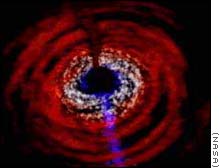|
|
Astronomers pinpoint black hole at center of Milky Way
|
||||
|
In this story: Triangulation was key Looking at things on a human time scale RELATED STORIES, SITES |
(AP) -- Astronomers have pinpointed with unprecedented accuracy an immense black hole with a mass of more than 2 million suns at the center of the spiral of stars that is the Milky Way galaxy.
The researchers have spent four years watching stars spin closer and faster around the black hole, an illustration of its powerful gravitational tug.
|
||||||||||||||
Researchers at the University of California, Los Angeles, led by Andrea Ghez, used the Keck telescope in Hawaii to measure tiny differences in infrared images of stars orbiting the estimated center of the galaxy near a point called Sagittarius A.
Radio waves emitted by Sagittarius A make it relatively easy to find through a thick veil of dust and gas, but measuring the orbital paths of nearby stars has been difficult.
Triangulation was key
The velocity, or speed of the stars, had been roughly measured, but the UCLA team took it a step further by using the infrared images of three stars to measure their acceleration -- or how fast the stars were speeding up -- and triangulate their center of rotation.
"And the nice thing is they intersect right on top, almost exactly, of this radio source, Sagittarius A, which people have long suspected is a black hole," said John Kormendy, an astronomer at the University of Texas in Austin.
The UCLA study, published Thursday in the journal Nature, is considered a major advance that lends support to other theories about the formation of galaxies and black holes.
"This has always been a major goal -- to try to figure out exactly where the center of our galaxy is," said Wallace Tucker at the Harvard-Smithsonian Center for Astrophysics in Cambridge, Mass.
Observations on a human time scale
The black hole could hold 2.6 million stars the mass of the sun inside a relatively tiny area -- less than the distance from the sun to Mars.
In addition to providing proof for the massive black hole, the discovery gives astronomers a chance to actually see the galaxy rotate about its center, and watch how it distorts and bends the orbits of nearby stars.
"We're used to looking at galaxies that change on times scales of millions and billions of years, but we never see them change because they change too slowly," Kormendy said.
"Now we can see so close to the center of our galaxy that things are actually happening on a human time scale. If things go OK, we're going to live to see this piece of the galaxy rotate right in front of our eyes, and that's very nice," he said.
Black holes are so dense they create gravity so strong that even light cannot escape their surface, making them nearly impossible to see. Kormendy said the black hole at the center of the galaxy is not pulling in other stars.
His research team has been searching other galaxies for signs of black holes, and so far has documented at least 37 similar galaxies that appear to have black holes at the center.
"We're finding in the search we're doing, and others have found too, that every time we point the Hubble space telescope at a galaxy that's got a bulge -- one of these more or less spherical cluster of stars in the middle -- we find a black hole every time," Kormendy said. "We haven't failed yet."
